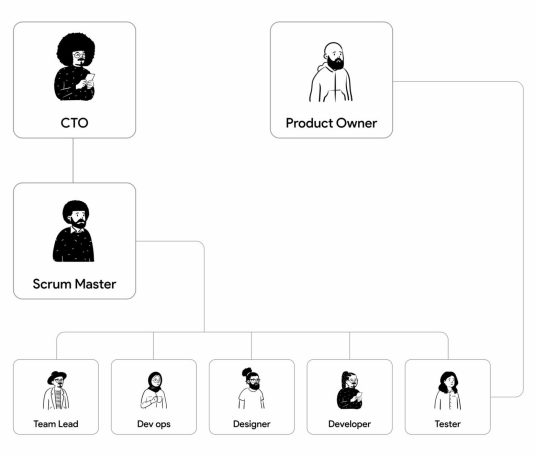Complete Guide to Ideal Software Development Team Structure
Do you want to build a high-performance development team? Let’s discover the optimal software development team structure that will allow you to create a better solution with fewer resources.

We all know that the quality and success of a software product largely depend on the people who create it, their experience, and the structure of the team. So naturally, as a founder, you might be asking yourself the question: what should be the ideal software development team structure? Let me be above board; there is no one-size-fits-all answer to this question.
The structure of the software engineering teams depends on a variety of factors, including the nature of the project, its complexity, budget, development period, and more. In this guide, we will discuss everything you need to know to identify those factors and figure out an effective organizational structure for your development team. Let’s get started.
Key Roles in a Software Development Team
Before we get too deep into complex factors and start drawing the software development org chart, let’s get to know the key people of a software development team.
Well, I have seen a development team with only one full-stack developer, but as you can guess, that is not ideal. Most of the successful development teams have 6/7 people, but you won’t see many roles in software development apart from these:
Product Manager
- Set goals for a product
- Recognize and represent the needs of consumers.
- Encourage collaboration across larger teams
Your product manager is the person who is responsible for A to Z of your product, from overseeing the development to the release and maintenance of your software products in the marketplace. The range of PM’s responsibilities is diverse. Setting goals for a product that reflects your company value is the main responsibility of your PM. His/ Her other duty involves prioritizing features according to the users needs, determining product requirements, analyzing product performance, ensuring quality, coordinating development activities of your teams, etc.
Engineering Manager
- Coordination and project management
- Allocation of resources
- Great talent acquisition
Your software development team’s engineering manager is in charge of ensuring that software development teams run smoothly and software solutions meet the highest quality standards. So your engineering manager needs to ensure the successful development of your software products by leading engineering teams, developing engineering processes, and providing technical expertise. He/She is also liable for coordinating development efforts, providing technical direction, managing project risks, facilitating team development, collaborating with other teams, and staying current with industry trends.
Software Architect
- Design architectural prototypes of software
- Provide expertise in leading teams
- Documenting every aspect of the software
Your software architect is the mastermind behind a software system, responsible for designing and supervising its development. He/she has the ability to take a complex problem and design the structure and framework, as well as technical requirements, for a scalable, efficient, and user-friendly software system. He/ she also manages project risks, collaborates with other teams, and ensures compliance with regulations and industry standards.
UI/UX Designers
- Illustrate design ideas
- Ensuring that software applications are user-friendly, consistent, and meet the needs of their target audience.
Do you want your user to feel instantly captivated by the design of your solution? Your UX/UI designers are the magicians who can turn your simple interface into a captivating and immersive experience. You need to know that UX and UI are related but still unique. UX (user experience) designers work with your software development teams to create designs to make sure every element of a website or app is optimized for maximum engagement and enjoyment for your users. Your User interface (UI) designers help make the UX designer’s ideas a reality. They work with color palettes, typography, icons, and other visual elements of your software.
QA Engineer
- Creates tests that identify issues
- Maintain quality standards of the product
Other experts who play an essential role in your software development teams are – QA (Quality Assurance) engineers. They are responsible for ensuring the quality of your software products before they are released to the market. QA engineers plan and develop test cases, execute them to identify defects or errors, report any issues discovered during testing to the development team, and work with them to resolve them. They continuously improve the testing process by identifying areas that need improvement, such as test automation or test data management.
Business Analyst
- Act as a central channel of communication between the various parties involved in a project, including developers, project managers, and clients.
Your business analysts act as a bridge between business stakeholders and development teams, they work to ensure that software meets the needs and expectations of end users. Business analysts are responsible for analyzing and documenting business needs, identifying areas for improvement, and recommending solutions that meet business goals. They have a deep understanding of your business processes, systems, and technology and use their knowledge to create innovative solutions that improve efficiency, reduce costs and increase revenue.
Scrum Master
- Create an environment that supports Scrum and manages blockers.
- Helps the team become self-organize and focus on outcomes.
Scrum Masters are facilitators, coaches, and mentors of software development teams following the Scrum methodology. Your scrum master ensures that your team sticks to the Scrum framework, which includes a set of principles and practices that promote agility, flexibility, and collaboration. He/She helps your teams understand their roles and responsibilities and helps them work effectively together to deliver high-quality software. They remove obstacles that can impede your team’s progress. Scrum Masters also help your teams continuously improve by reducing retrospectives and encouraging the adoption of new practices and processes.
Team Lead
- Is in charge of the whole software development team
Your team lead – the professional who leads and manages your software development teams. He/ she manages the day-to-day operations of the team, provides technical guidance and direction, and ensures that the team follows best practices and uses appropriate technology. Your team leader is also responsible for managing project risks, facilitating team collaboration and communication, and continuously improving the software development process.
Developers (Front-end, Back-end)
- These are the people who are in charge of actual coding.
- Front-end developers focus on the visual aspects (user-facing aspects) of a website.
- Back-end developers deal with the server side of a website as well as the functionalities and complex algorithms.
As I mentioned earlier, developers are the actual coders. They are the ones who write thousands of lines of code and shape the software. In most cases, a development team has both front-end and back-end developers who collaborate together to build the application following the team lead’s instructions.
Key Factors Affecting Team Structure in Software Development
To effectively manage a software development team, there needs to be more than knowing the roles of a software development team. You need to understand the various factors influencing software development team structure. By understanding the following key factors, you can create well-suited teams that meet their specific projects’ needs.
Nature And Complexity Of The Project
The first key factor you should keep in mind is the nature and complexity of the project while determining the team structure. If your project is complex, you may need a larger team with specific skills to handle the project’s complexity. However, if your project is relatively simple and smaller, a small team is sufficient to get the job done.
Type of the Development Team
While building a development team, you have several options. You may hire all developers for your startup by yourself and build an in-house team. Or you may outsource software development and build an offshore team to reduce cost or keep some people in-house and hire some with your offshore partner. But whatever option you choose will have an impact on your software development team structure.
Project Timeline
When working on a software development project, the project timeline is another important factor affecting your team structure. If your project has a shorter deadline, you may need a larger team to ensure that the project is completed on time.
Conversely, a smaller team may be better suited to the job if you have a longer project. Therefore, it is important to consider the project timeline when deciding the team structure to ensure that the project is completed efficiently and effectively.
Development Project Budget
You should consider the project budget before forming a software development team. If your project has a bigger budget, you can hire a bigger team to fulfill the project requirements. Contrariwise, if you have a smaller budget, a smaller team may be better suited to ensure that the project is completed within budget.
Software Development Methods
Different software development methodologies, such as agile or waterfall, have different team structures. For example, agile methods often involve smaller cross-functional teams working closely together to efficiently complete projects. On the other hand, a waterfall approach may require larger, more specialized teams to handle different phases of a project separately. So before deciding on a team structure, you should do some research about the software development methodology that would work best for your specific project.
Team Location
When structuring a software development team, it is essential to consider the location of the team members because it affects the team structure. If your team members are located in different geographic locations, you may need to adjust your team structure accordingly.
For example, you may need to rely more on virtual communication tools, have team members work in shifts, or assign different team leaders to each location. The team structure may require little adjustment if all team members are in one location.
Team Size
You need to remember that team size is also an important factor that affects team structure. A smaller team may be more appropriate if your project is smaller because it allows for more flexibility and faster decision-making. However, for larger, more complex projects, larger teams may be better suited to handle the complexity of the project. So you should consider the size of the project and carefully determine the appropriate team size to implement the project effectively and efficiently.
Common Product Development Team Structure Approaches
Now that you know the key factors that affect the team structure. It’s time to move on to team structure approaches. There are three types of common product development team structure approaches:
Generalist Team Structure
These are the teams made up of Jack of all trades. If you choose to adopt a generalist team structure, your team members will have a broad range of skills and experience. However, they will not necessarily have deep expertise in any specific area. This team structure is often used by most outsourcing companies, small companies, or sales departments where team members need to be versatile and able to carry out a variety of tasks.
Pros:
- Each team member can handle multiple tasks and responsibilities.
- Adaptability and flexibility in response to changing project requirements.
- Cost-effective as fewer team members are needed.
Cons:
- Lack of depth in specific areas of expertise.
- The absence of specialists leads to a high probability of lower product quality.
- Difficulties in scaling the team as the project grows.
Specialist Team Structure
You can understand just by reading the name that this approach involves experts who are highly skilled in specific areas, in short, “the master of one” type of people. They have predefined roles in solving complex problems during the product management process. This approach is often used in larger teams with every specialist for every area imaginable, providing a high level of expertise for your product development needs.
Pros:
- Deep expertise in specific areas.
- High-quality work due to specialization.
- Ability to scale the team as the project grows.
Cons:
- Lack of flexibility and adaptability.
- Potential for silos to form between team members.
- Higher costs due to specialized staff.
Hybrid Team Structure
If you’re looking to build a successful startup or team, the hybrid team structure can be an excellent option to consider. By combining the expertise of specialists with the flexibility of generalists, you can create a team that works together seamlessly, takes ownership of their work, and produces high-quality results.
Pros:
- Balance of broad and deep skills in a team.
- High-quality work and adaptable in case of changes.
- Ability to scale the team as the project grows.
Cons:
- Requires careful coordination between team members.
- Cost more than others if not optimized well.
- It might be Complex to set up and manage.
2 Most Common Development Team Structure Based on Methodology
The approach to development team structure must be aligned with the methodology you use to ensure that your team is organized in a way that supports the methodology’s goals and principles. In this part, you will understand the two most common development team structures based on methodology.
Traditional Software Development Team
The first one is the traditional software development team. This one is based on the waterfall methodology.
If you’re considering using the waterfall methodology in your software development projects, it’s essential to understand how it works. This approach follows a strict series of phases, and each phase must be completed before moving on to the next. The process begins with a thorough understanding of the project scope and requirements, followed by a design and planning phase, followed by implementation, testing, and, finally, deployment.
When using the waterfall method, you will find that it is very structured and follows a sequence of steps. For this to work, your development team must be organized to support this approach. Typically, your team will be divided into functional groups, each responsible for a specific phase of the development process. This allows each team member to focus on their area of expertise and work within clear boundaries and responsibilities.
As you work through each stage of the waterfall methodology, you will notice that the project manager plays a vital role in overseeing the team and ensuring that each stage is completed before moving on to the next. This approach is consistent with the top-down management style, where the project manager takes control and ensures that everything goes according to plan.
Agile Software Development Team
Agile is currently one of the most popular software development methodologies because it delivers high-quality software products quickly and efficiently.
Let’s say you’ve decided to adopt a team structure based on the agile methodology. According to this methodology, your large project will be divided into small, manageable increments or sprints.
At the beginning of each sprint, you and your team plan out the work that needs to be done, assign tasks, and set a goal for the sprint. Throughout the sprint, you work together to complete the assigned tasks, have daily meetings to track progress and give feedback to solve any issues that may arise. At the end of each sprint, you and your team review the work completed and discuss which part went well and what could be improved. And then repeat the same process.
As you begin your journey, you quickly realize that Agile methodology promotes a more flexible and collaborative team structure. Your team will follow the concept of self-organizing and self-management, with each member taking on multiple roles and responsibilities and working across cross-functional teams. You will also notice that the team is more adaptable and can quickly respond to changing requirements, which is crucial in today’s fast-paced business environment. Your agile teams consist of no more than ten people, a Scrum Master or Service Delivery Manager, with different responsibilities than traditional project managers. Instead of focusing on strict control and oversight, he/she prioritizes building solid relationships within the team and creating an environment that enables each team member to thrive.
As far as you read, the detail of both team structures. Here is an overview comparison between the waterfall team structure and the agile team structure.
| Factor | Waterfall team structure | Agile team structure |
| Management | Involves management from up high, where the project manager has to ensure success. | The teams are self-organized and self-managed |
| Customer interaction | Low degree of customer involvement | Teams include representatives of the customers |
| Performance evaluation | Concentrate on individuals | Concentrate on the whole team |
| Collaboration and synchronization | Low degree | High degree |
| Communication | Flows from the top-down | Is encouraged to be open, transparent, and collaborative |
| Roles | Specific role duties and titles | Cross-functional teams |
| Projects | Teams often manage multiple projects at once | Teams tend to concentrate on one project at a time |
| Team members are interchangeable | No | Yes |
| Team size | No limit | Up to ten |
So, Which Model is Best for Startups?
As you can see, agile methods have many benefits over more traditional waterfall approaches, including greater flexibility, faster delivery times, and better collaboration between team members which is perfect for your startup.
Agile methods make it easier to change plans and improve the final product by dividing projects into small, manageable chunks called “sprints” and encouraging self-organization and self-management within the team – satisfying the need for your startup’s adaptability to rapid shifts in market conditions.

Although it may not be appropriate for every project or organization, agile methods have proven to be an effective and efficient way to manage complex software development projects. So it’s worth considering whether agile is the right approach for your startup.
Designing an Ideal Software Development Team Structure
So, now you know all the factors, roles, and methods to design an ideal software development team. How would you design the structure of your development team? What would be the composition of your agile development team?
Let’s answer this question with an example, say you want to build a development team to release a new feature of your web app. As we already know, agile is the answer; we will create the team following the famous scram methodology of agile development, which typically consists of a cross-functional team of 6 to 9 people.
In this example, we have a 6-person team to account for the additional roles of Product Owner, Scrum Master, and CTO, which are essential in driving the product vision and guiding the team’s agile process. The senior management team is really there to help strategize and monitor progress and provide feedback.

The core agile team of 6 people will be led by a team leader. The team also includes three developers who work on building and maintaining the product, 1 UX/UI designer who is responsible for creating user-focused designs, and 1 QA engineer who makes sure the product meets product requirements and quality.
This team structure is designed to promote collaboration and communication among team members, allowing them to work together efficiently and effectively to deliver the web application feature in a timely manner.
But as I mentioned earlier, there is no one-size-fits-all model. Your development team may be a different size. You can also include DevOps in your team (which is actually recommended). Add more developers or designers. The possible ideal combination is limitless as long as you are promoting collaboration and productivity.
Footnote
Identifying and creating the ideal software development team structure can be a complex and challenging task, but it is critical to the success of any software project. The right structure can make a significant difference in productivity, efficiency, and quality of the final product. Consider all of the factors we mentioned above when creating your software engineering organizational structure. And if you need help determining the structure of your software engineering team, you can talk to our co-founder Reza, who has over 10 years of experience building teams and building products users love to use.






